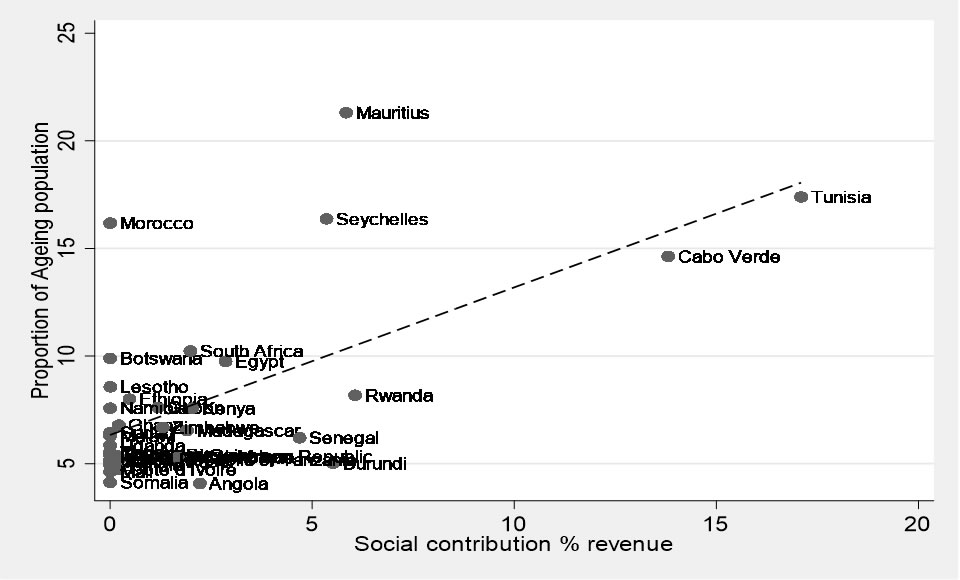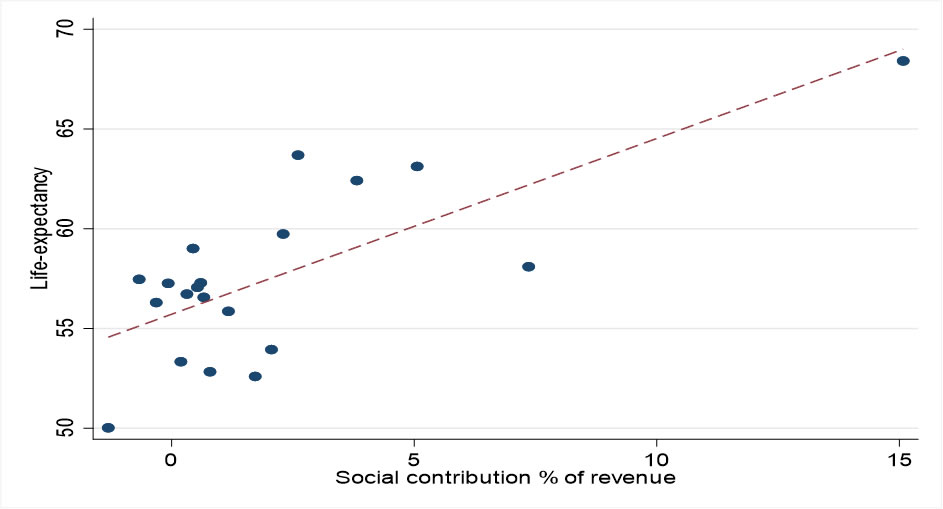As the size of the ageing population expands and jobs with decent pension schemes grow slowly, social protection programs designed to care for the ageing population face serious challenges of targeting, sustainability, and affordability. This brief provides insights on the effectiveness of existing social policies in caring for the elderly and draws some lessons that could improve the provision of social protection based on experiences of some of the successful countries.
The task of instituting a functioning social security programs, targeted social protections and well-defined basic health facilities for the elderly remain a big challenge. Below I provide some suggestive evidence on common indicators used to capture social policies for the ageing population. These are share of social contributions to total government revenue. This indicator provides information on the share of contributions made directly by employees (for example civil servants, employees of state-owned enterprises, etc.) or on their behalf by public or private companies depending on the type of pension schemes. The global average is around 8.3%[1] in 2019, while for Africa it was 4.8% with considerable variation across countries.
Figure 1 reports a strong and positive association between social contributions as a share of total government revenue and the size of the elderly population in Africa. Countries that tended to expand social contributions (pension schemes, unemployment benefits, etc.,) seem to have gained through improved life-expectancy, hence higher size of the elderly population.
Figure 1: Proportion of the ageing population and social contribution as a share of revenue

Source: author’s computations. Note: the graph plots social contributions as a share of total government revenue averaged over the period 1990-2020 against the proportion of the ageing population among African countries.
- While middle income countries such as Mauritius, Seychelles, and Tunisia tended to have high social contributions as well as high proportion of the ageing population, countries such as Botswana, Morocco and South Africa have low social contribution rate yet relatively high proportion of ageing population indicating the potential role of per capita GDP in improving life expectancy.
- Whereas countries such as Angola with comparable per capita GDP and social contributions as that of Botswana recorded low proportion of the ageing population which indicates the complexity in understanding the drivers of the ageing population.
Figure 2 complements the role social policy plays in improving the size of the elderly population by mapping the share of the population covered under social insurance with the size of the elderly population, showing a strong positive association. Countries such as Egypt and Ghana lead by providing social insurance for over 20% of their population which is the highest coverage in Africa. Nearly all other African countries had only a fraction of the population had access to social insurance.
Figure 2: Proportion of the ageing and social insurance coverage in Africa

Source: author’s computations based on World Development Indicators (various editions)
Note: The graph plots average values of social insurance coverage as percentage[2] of population with respect to the proportion of the ageing population for the period 1990-2020.
While few countries have implemented alternative pension systems to care for the elderly, it is also possible to argue that the ageing population benefited from basic social services provided by governments that improved welfare. To examine the association between social policies and the ageing population, Figure 3 displays a diagram between life-expectancy (proxy for better care for the elderly population) and social contributions after accounting for differences in the level of
development (or per capita GDP). The relationship as shown is strong and indicative of the influence of social policies on welfare of the elderly population in Africa.
Figure 3: Bin-scattered diagram of life-expectancy and social contributions in Africa

Source: author’s computations.
The relationship between ageing population and social policies (social contributions and social insurance coverage) is mediated through life-expectancy. Countries that run a very good social programs (like social contributions and insurance) tend to register better life-expectancy after controlling for differences in the level of development (per capita GDP). The same relationship holds between public spending on health as a share of GDP and the welfare of the elderly.
In conclusion, even though social policies targeting the care of the elderly are at a formative stage in many African countries, the existing programs seem to have some degree of positive effect on the welfare of the elderly as discussed above. More research is needed to see if the pension schemes and other social benefits, such as health care are commensurate with the size of social contributions and social insurance schemes so that reforms can be implemented to improve the caring for the elderly. In this regard, Africa also has a huge potential in rolling out better social policies for the ageing population as the structure of its economy improves over time. Figure 4 below shows that
there is strong and negative association between share of the labor force in the informal sector and the share of the ageing population suggesting the possibility that in the long-term more contributory pension schemes could evolve in Africa.
Figure 4: Informality and the ageing population in Africa

Source: author’s computations based on data from UNFPA (2021) and ILO (2020)
[1] See https://data.worldbank.org/indicator/GC.REV.SOCL.ZS
[2] According to the World Bank (https://datacatalog.worldbank.org/coverage-social-insurance-programs-population-0) the data on the percentage of the population with social insurance is defined as follows ”Coverage of social insurance programs shows the percentage of population participating in programs that provide old age contributory pensions (including survivors and disability) and social security and health insurance benefits (including occupational injury benefits, paid sick leave, maternity and other social insurance). Estimates include both direct and indirect beneficiaries
This brief is based on the author’s contribution to a policy paper “Policy Brief on Ageing, Social Protection, and Covid-19 pandemic in Africa”, September 2021, Gender, Poverty and Social Policy Division, UNECA
- The ageing population of Africa is increasing, so it’s suffering - October 10, 2021
- Are social protection programs effective in caring for the elderly in Africa? - October 5, 2021
- For whom the bell tolls? Social Protection in Africa during Covid-19 pandemic - September 30, 2021

